Engage NY Eureka Math Geometry Module 1 Lesson 11 Answer Key
Eureka Math Geometry Module 1 Lesson 11 Example Answer Key
Example 1.
Construct a proof designed to demonstrate the following:
If two lines are perpendicular to the same line, they are parallel to each other.
(a) Draw and label a diagram, (b) state the given facts and the conjecture to be proved, and (c) write out a clear statement of your reasoning to justify each step.
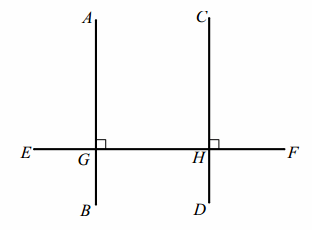
Answer:
Given: \(\overline{A B}\)⊥\(\overline{E F}\), \(\overline{C D}\)⊥\(\overline{E F}\)
Prove: \(\overline{A B}\) || \(\overline{C D}\)
m∠AGH=90°; m∠CHF=90° Perpendicular lines form 90° angles.
m∠AGH=m∠CHF Transitive property (since m∠AGH=90° and m∠CHF=90°)
\(\overline{A B}\) || \(\overline{C D}\) If two lines are cut by a transversal such that a pair of corresponding angles are equal in meaure, then the lines are parallel.
Discussion
Show a brief example of one parallel line theorem in both directions, the original theorem and its converse, to ensure students understand how to use the converse (one way is using student helpers mentioned in the overview).
Each of the three parallel line theorems has a converse (or reversing) theorem as follows:

Notice the similarities between the statements in the first column and those in the second. Think about when you would need to use the statements in the second column, that is, the times when you are trying to prove two lines are parallel.
Example 2.
In the figure to the right, x=y.
Prove that \(\overline{A B}\) || \(\overline{E F}\).
Answer:
x=y Given
\(\overline{A B}\) || \(\overline{E F}\) If two lines are cut by a transversal such that a pair of corresponding angles are equal in meaure, then the lines are parallel.
Eureka Math Geometry Module 1 Lesson 11 Exercise Answer Key
Opening Exercise
A proof of a mathematical statement is a detailed explanation of how that statement follows logically from other statements already accepted as true.
A theorem is a mathematical statement with a proof.
Consider taking a moment to mention that theorems can be stated without reference to any specific, labeled diagram. However, we cannot take steps to prove a statement without a way of referring to parts. Students observe situations where the labels are provided and situations where they must draw diagrams and label parts.
Discussion
Once a theorem has been proved, it can be added to our list of known facts and used in proofs of other theorems.
For example, in Lesson 9, we proved that vertical angles are of equal measure, and we know (from earlier grades and by paper cutting and folding) that if a transversal intersects two parallel lines, alternate interior angles are of equal measure. How do these facts help us prove that corresponding angles are equal in measure?
Answer:
Answers may vary.
In the diagram to the right, if you are given that \(\overline{A B}\) || \(\overline{C D}\), how can you use your knowledge of how vertical angles and alternate interior angles are equal in measure to prove that x=w?
Answer:
w=z (Vertical angles are equal in measure.)
z=x (Alternate interior angles are equal in measure.)
x=w (Substitution)

You now have available the following facts:
→ Vertical angles are equal in measure.
→ Alternate interior angles are equal in measure.
→ Corresponding angles are equal in measure.
Use any or all of these facts to prove that interior angles on the same side of the transversal are supplementary. Add any necessary labels to the diagram below, and then write out a proof including given facts and a statement of what needs to be proved.

Given: \(\overline{A B}\) || \(\overline{C D}\), transversal \(\overline{E F}\).
Prove: m∠BGH+m∠DHG=180°.
Answer:
\(\overline{A B}\) || \(\overline{C D}\) Given
m∠BGH+m∠AGH=180° Linear pairs form supplementary angles.
m∠AGH=m∠DHG If parallel lines are cut by a transversal, then alternate interior angles are equal in measure.
m∠BGH+m∠DHG=180° Substitution property of equality
Now that you have proven this, you may add this theorem to your available facts.
→ Interior angles on the same side of the transversal that intersects parallel lines sum to 180°.
Use any of these four facts to prove that the three angles of a triangle sum to 180°. For this proof, you need to draw an auxiliary line parallel to one of the triangle’s sides and passing through the vertex opposite that side. Add any necessary labels, and write out your proof.

Answer:
Draw an auxiliary line JK so that \(\overleftrightarrow{J K}\) || \(\overleftrightarrow{B C}\).
atex]\overleftrightarrow{J K}[/latex] || \(\overleftrightarrow{B C}\) Construction
d+a+e=180 Angles on a line sum to 180°.
d=b If parallel lines are cut by a transversal, then alternate interior angles are equal in measure.
e=c If parallel lines are cut by a transversal, then alternate interior angles are equal in measure.
a+b+c=180 Substitution property of equality
Let’s review the theorems we have now proven:
→ Vertical angles are equal in measure.
→ A transversal intersects a pair of lines. The pair of lines is parallel if and only if:
→ Alternate interior angles are equal in measure.
→ Corresponding angles are equal in measure.
→ Interior angles on the same side of the transversal add to 180°. The sum of the degree measures of the angles of a triangle is 180°.
→ What is the absolute shortest list of facts from which all other facts can be derived?
Side Trip: Take a moment to take a look at one of those really famous Greek guys we hear so much about in geometry, Eratosthenes. Over 2,000 years ago, Eratosthenes used the geometry we have just been working with to find the circumference of Earth. He did not have cell towers, satellites, or any other advanced instruments available to scientists today. The only things Eratosthenes used were his eyes, his feet, and perhaps the ancient Greek equivalent to a protractor.
Watch this video to see how he did it, and try to spot the geometry we have been using throughout this lesson.
Eureka Math Geometry Module 1 Lesson 11 Problem Set Answer Key
Question 1.
Given: ∠C and ∠D are supplementary and m∠B=m∠D Prove: \(\overline{A B}\) || \(\overline{C D}\)
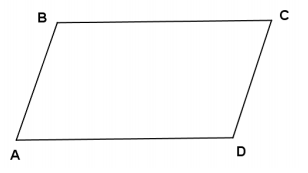
Answer:
∠C and ∠D are supplementary. Given
m∠C+m∠D=180° Definition of supplementary angles
m∠B=m∠D Given
m∠C+m∠B=180° Substitution
\(\overline{A B}\) || \(\overline{C D}\) If two lines are cut by a transversal such that a pair of interior angles on the same side are supplementary, then the lines are parallel.
Question 2.
A theorem states that in a plane, if a line is perpendicular to one of two parallel lines and intersects the other, then it is perpendicular to the other of the two parallel lines.
Prove this theorem.
(a) Construct and label an appropriate figure,
(b) state the given information and the theorem to be proven, and
(c) list the necessary steps to demonstrate the proof.
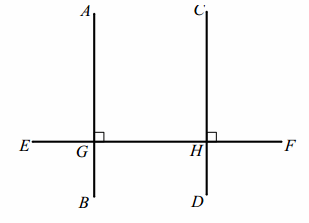
Answer:
Given: \(\overline{A B}\) || \(\overline{C D}\), \(\overline{E F}\) ⊥ \(\overline{A B}\), \(\overline{E F}\) intersects \(\overline{C D}\)
Prove: \(\overline{E F}\)⊥\(\overline{C D}\)
\(\overline{A B}\) || \(\overline{C D}\), \(\overline{E F}\)⊥\(\overline{A B}\) Given
m∠BGH=90° Definition of perpendicular lines
m∠BGH=m∠DHF If parallel lines are cut by a transversal, then corresponding angles are equal in measure.
\(\overline{E F}\)⊥\(\overline{C D}\) If two lines intersect to form a right angle, then the two lines are perpendicular.
Eureka Math Geometry Module 1 Lesson 11 Exit Ticket Answer Key
In the diagram to the right, prove that m∠d+m∠e-m∠a=180°.
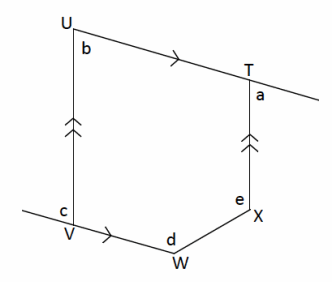
Answer:
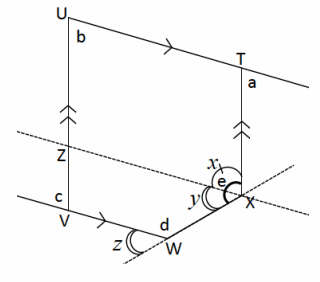
Draw an auxiliary line through X parallel to\(\overleftrightarrow{\boldsymbol{V W}}\), and label the intersection of this line with \(\overline{U V}\) as Z. Extend \(\overline{W X}\), and label angles as shown.
\(\overleftrightarrow{\boldsymbol{T} \boldsymbol{U}}\) || \(\overleftrightarrow{\boldsymbol{X} \boldsymbol{Z}}\) Given
\(\overleftrightarrow{\boldsymbol{X} \boldsymbol{Z}}\) || \(\overleftrightarrow{\boldsymbol{V} \boldsymbol{W}}\) Construction
m∠a=m∠x If parallel lines are cut by a transversal, then alternate interior angles are equal in measure.
m∠y=m∠e-m∠x Angle postulate
m∠y=m∠z If parallel lines are cut by a transversal, then corresponding angles are equal in measure.
m∠d+m∠z=180° Linear pairs form supplementary angles.
m∠d+m∠e-m∠a=180° Substitution property of equality.